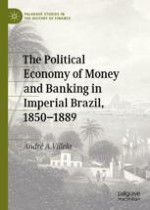2020 | OriginalPaper | Chapter
5. Taking Stock: Monetary and Banking Policy in the Second Reign
Author : André A. Villela
Published in: The Political Economy of Money and Banking in Imperial Brazil, 1850–1889
Publisher: Springer International Publishing
Activate our intelligent search to find suitable subject content or patents.
Select sections of text to find matching patents with Artificial Intelligence. powered by
Select sections of text to find additional relevant content using AI-assisted search. powered by
